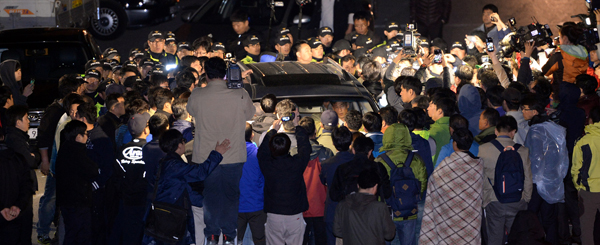Ministry blamed for slow ferry response

Relatives of missing passengers from the Sewol surround the car of Prime Minister Chung Hong-won in Jindo, South Jeolla, early yesterday morning in an expression of frustration and fury over the rescue operations after their march to the Blue House in Seoul was thwarted by the police earlier in the day. [NEWSIS]
In February, the Park administration changed the law to strengthen the Security Ministry’s role in disaster management. That weakened the role of the National Emergency Management Agency, which has more experience.
After the distress of the Sewol ferry was first reported to the South Jeolla Fire Service by an unidentified person, possibly a ferry passenger, at 8:52 a.m., - which was six minutes before the ship’s first distress call to the Coast Guard at 8:58 a.m - it took 53 minutes for the government’s Central Disaster and Safety Countermeasures Headquarters to start efforts to rescue the 476 people on the ferry.
The headquarters is the organization in charge of any large natural or man-made catastrophe. Since 2004, it has been headed by the Minister of Security and Public Administration, who decides on whether or not to run the headquarter.
Security Minister Kang Byung-kyu was on a domestic business trip Wednesday morning. He was told of the ferry’s capsizing at 9:25 a.m., sources told the JoongAng Ilbo, and ordered officials of his ministry to command the headquarters at 9:39 a.m.
But according to the sources, it was only at 9:45 a.m. that the headquarters actually started its work.
The 6,825-ton ferry was listing to port at about 60 degrees at 9:37 a.m., according to survivors and the captain, and it capsized completely at around 11:20 a.m.
Sources told the JoongAng Ilbo that when the government deems a disaster has reached “a serious level,” the Security Minister decides whether or not to operate the headquarters.
If the minister decides he will command the headquarters, other government organizations are supposed to cooperate and dispatch their own officials there.
In the past, in the case of a man-made disaster, the vice security minister takes vice chairmanship of the headquarters. In the case of a natural disaster, however, the head of the National Emergency Management Agency (NEMA), an independent organization of disaster specialists and experienced rescue workers, took the second-most-powerful post.
Even when the head of the command is the security minister, many high-ranking posts in the command can be taken by officials from NEMA.
But under the Park Geun-hye administration, a law on operation of the headquarters was revised on Feb. 7. The new law gives more power to the Security Ministry, not NEMA, as part of Park’s attempt to stress public security.
Under the new law, the vice minister of security and public administration was named vice chairman of the control tower dealing with all kinds of disasters.
All of the managerial positions were taken by officials from the Security Ministry.
“When a disaster breaks out, it is an opportunity for Security Ministry officials to communicate directly with the president,” a disaster specialist said under the condition of anonymity. “So, for this reason, some say the Security Ministry deliberately edged out NEMA officials from the headquarters.
“When the law [on the management of the headquarters] was revised [on Feb. 7], there was concern that it would cause problems in initial responses to a crisis because the Security Ministry officials are inexperienced in dealing with disasters,” the specialist said.
“When the roof collapsed in the Mauna Ocean Resort in Gyeongju, NEMA launched its own emergency headquarters and took speedy measures, preventing further casualties,” another disaster specialist said.
“In this case, if the Coast Guard were appointed as directors at the headquarters at the beginning of the incident, they would have saved more people.”
Analysts said the government should pass a pending bill to launch a nationwide disaster safety network to enable rescue workers on the scene to communicate directly with officials in Seoul.
“If we had such a networking system, rescue workers at the scene could directly communicate with the headquarters [in Seoul],” Kim Nam, a telecommunication studies professor at Chungbuk National University, said.
BY CHANG SE-JEONG, KIM HEE-JIN [heejin@joongang.co.kr]










with the Korea JoongAng Daily
To write comments, please log in to one of the accounts.
Standards Board Policy (0/250자)